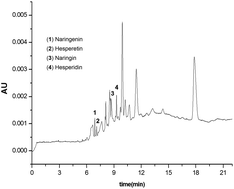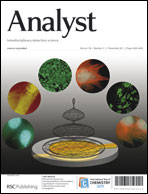On-line concentration via Electrokinetic Supercharging (EKS) was used to enhance the sensitivity of the capillary electrophoretic separation of the four flavonoids naringenin, hesperetin, naringin and hesperidin. Separation conditions, including the background electrolyte pH and concentration, the length and choice of terminator and the electrokinetic injection time were optimized. The optimum conditions were: a background electrolyte of 30 mM sodium tetraborate (pH 9.5) containing 5% (v/v) of methanol, electrokinetic injection of the sample (130 s, −10 kV) followed by hydrodynamic injecting of 100 mM 2-(cyclohexylamino)ethanesulfonic acid (CHES) (17 s, 0.5 psi) as terminator, and separation with −20 kV. Under these conditions the four flavonoids could be separated with a sample-to-sample time of 15 min and detection limits from 2.0 to 6.8 ng mL−1. When compared to a conventional hydrodynamic injection the sensitivity was enhanced between 824 and 1515 times which is 7.6-16 times higher than other CE methods for the on-line concentration of flavonoids. The applicability of the developed method was demonstrated by the detection of the four flavonoids in an aqueous extract of Clematis hexapetala pall.

You have access to this article
 Please wait while we load your content...
Something went wrong. Try again?
Please wait while we load your content...
Something went wrong. Try again?


 Please wait while we load your content...
Please wait while we load your content...